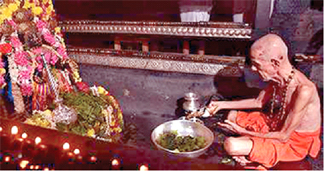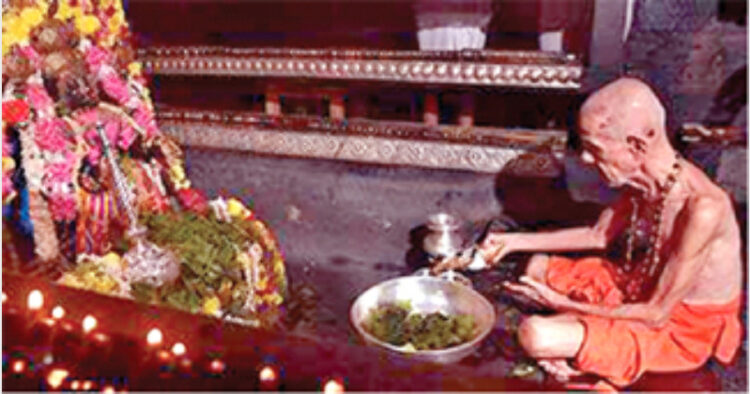The recent move by the Karnataka Government to confer minority status on the Lingayats has been severely criticised as an attempt to divide the Hindu community
D K Hari & D K Hema Hari
 Lingayat is a distinct Shaiva sect in India. Shaiva is one of the Shadmadam, which worships Shiva as the Supreme Divinity. Shad means six and Mada, meaning relating to mind, is etymologically similar to Mati, Mat, Maths, Mathematics. Ishtalinga is an oval-shaped lingam which represents Shiva, and is worn around the neck on a string. Another sect similar to Lingayats is the Veera Shaivas. Veera Shaivas are staunch devotees of Shiva and follow the Vedic tenets of living.
Lingayat is a distinct Shaiva sect in India. Shaiva is one of the Shadmadam, which worships Shiva as the Supreme Divinity. Shad means six and Mada, meaning relating to mind, is etymologically similar to Mati, Mat, Maths, Mathematics. Ishtalinga is an oval-shaped lingam which represents Shiva, and is worn around the neck on a string. Another sect similar to Lingayats is the Veera Shaivas. Veera Shaivas are staunch devotees of Shiva and follow the Vedic tenets of living.
Around 12th century CE, revolting against the manner in which organisation of the society and rituals were then being practised, Sri Basava, a statesman, philosopher, poet and social reformer, popularly known as Basavanna, instituted a new sect.
Basavanna rejected the Veda, the Vedic tenets and the then forms of worship to setup a new system based on a formless divinity symbolised by an oval shape called Ishta Linga worn around the neck itself. This system came to be called Lingayat, those who wear an Ishta Linga. The term Lingayat is derived from the word Lingavanta, which means “One who wears an Ishtalinga.”
Many Veera Shaiva attracted by the teachings of Basavanna converted to become a Lingayat. Soon the states of Karnataka and Andhra saw an increase in the number of Lingayats.
Over the time, however, the distinction started blurring and Lingayat and Veera Shaiva were seen. The Veera Shaiva and Lingayats themselves too started believing it to be so, though deep down in the Lingayat sect, there was some amount of apprehension.
Demands of Lingayats
In the last century, with more of the Lingayat literature being searched for and researched for a better understanding, this apprehension has given way to an affirmation that the Lingayats are different from Veera Shaiva.
This clarity clubbed with the status that minority religions, i.e non-Hindus, enjoy in terms of benefits from the state, as well as the sway that minorities could hold on politics and Governance, sowed the seeds for the Lingayats wanting a minority status. Their claim is that the teachings of Basavanna, that form the core of the Lingayat sect, were different from the Veda and the core of Hinduism, as is perceived. Hence they should be classified as non-Hindus. There have therefore been demands by the leaders of the Lingayat community to declare their sect as a different, non-Hindu and a minority religion.
Channappa Uttangi, a Christian Missionary who recorded the teachings of Lingayat Guru Basaveswara, was the first one who started a protest in 1940 to declare Lingayat as a separate religion. He preached that “Basava is the best Christian and Christ is the best Lingayat’.
Ambedkar’s view
When our constitution was drafted by the Constituent Assembly, Dr B. R. Ambedkar, one of the architects of the Indian Constitution, had made it clear that the term Hindu, includes all those who are not Christians, Muslims and Parsis.
Which means that the term “Hindu” covered everybody, including Buddhists, Jains, Sikhs, Nature worshippers, Adi Vasis, Vana Vasis and even Veera Shaiva as well as Lingayats. constitutionally.
We know from ancient times six religions were practised in Bharat.
Shaivam where Shiva and role played by Shiva is in focus, as without potential to manifest, matter and elements of matter, there is no Universe.
Vaishnavam where Vishnu and role of Vishnu is given prominence
Shaktam where energy is given prominence, as energy is an intrinsic aspect of everything.
Sauram where Sun is given prominence as the sustainer of the earth as well as life on earth.
Ganapathyam where intellect is given prominence as, without intellect, all of these are as good as non-existent. The focus is more on mankind and his capabilities.
Kaumaram where beauty and design is given prominence as without this design and beauty, this Universe would not have evolved as it has.
Adi Shankara mentioned about Shadmada about 2500 years ago.
Hinduism
This word Hindu itself is of recent origin and did not exist in ancient India. The Persians referred to the land to the East of the Sindhu River as Hind by interchanging S with H. The term Hindustan was coined to describe the Stan, the place or the area around the Sind, Hind, Indus River. The inhabitants of this area were called Hindustani. Thus the term “Hind” was a geographical identity and not a religious identity to start with. But this word stuck and has been used collectively to denote the religions and sects that had their origin in India.
Ancient India had been practising these 6 forms of “religion” based on the Veda, from time immemorial. Various religious leaders, Guru, Acharya, Mathas and Ashrama have risen in each of these six “religions” at various points in time.
These six, were largely similar and minutely different. People of these 6, along with other religions in India then, such as Buddhism, Jainism and other tribal sects, all of which had their origin in India, were all clubbed together as a single people called “Hinduan” by Isami, an Islamic Medieval Historian of 1350 CE.
Hinduans were Indians who were non-Islamic in religion according to him. Prior to this, Isami cites how Indians in Persia and Arabia were called Hindian, irrespective of their religion. So while “Hindian” was a geographical classification and included all from India, “Hinduan” was a 14th-century religious classification which included all non-Muslims of India. This “Hinduan” made it easy for the British to extend the religious classification further in 1829 to “Hindu”, which stood for all non-Muslims and non-Christians.
The Constitution of India, while being framed, further cemented the term “Hindu” as that which refers to anybody who is not a Muslim, Christian or a Parsi. Every other Indian is thus a Hindu. Thus, if we look at it historically, the Hindu religion has an antiquity of a just about 190 years only, when the British coined the term “Hindu”. Now, based on this, are Lingayats Hindus or non-Hindus?
After independence, some Hindu sects had made attempts to get themselves a distinct minority status to gain freedom from the constant interference of the Government.
The Ramakrishna Mission in Kolkata, in the courts, tried to classify themselves as minorities, but in 1995, the Supreme Court of India rejected their claims of being a separate religion.
Similarly, in Tamil Nadu, a sect of Shiva worshippers have a separate prayer to Shiva, who they claim is a Shiva different from the Shiva of the Vedic thought.
They have been speaking on this distinct identity of their Shiva for centuries and millennia, with their prayer call being, “Thennnattudaya shivanae pottree,” meaning “Praise be to the Shiva of the southern land”, who they differentiate from the Shiva of the Vedic system.
Congress Gameplan
It was the Congress, which, during the freedom struggle, accepted an amalgamated concept of Hindu religion when one did not exist and supported the British lawmakers and the then court judgements, in making Hinduism a single religion for British administrative conveniences.
Later, through the Constituent Assembly and the Constitution, it thereby cemented and created this present body of Hindu religion.
Now, it is the same Congress party, four generations later, that is trying to make a piecemeal and separate the Hindu religion bit by bit, for its local political conveniences. In the garb of secularism, Minoritism was brought in by Jawaharlal Nehru. This was one of the blunders committed in a newly Independent India.
Minoritism was a blunder done at the time of creating the Constitution. Dr Babasaheb Ambedkar did not want it for the reason that it creates two classes of citizens. Subsequent governments have not had the will, courage nor the mandate to undo it.
Because of this, India is the only country where people, instead of wanting to be in the majority want to be a minority. Unequal Acts such as the Right to Education (RTE) have widened the divide and given unfair privileges to the minorities.
Option One: This one stroke of action will remove once and for all, the majority and minority appeasement which has been a pain since independence. Along with this step an Amendment of Articles 25 to 30, abolishment of the Ministry of Minority Affairs, repealing of the NCM and scrapping Majority/Minority Distinction in RTE would be needed.
Option Two: Make Everyone a Minority. If one component of this amalgamated group is allowed to demand minority status and be granted the same, then the same option should be made open for each component to demand minority status.
Option Three: Yet another, long lasting and bolder alternative would be to redefine Hinduism and the definition of the term “Hindu” based on the history of this term itself and how it has worked in the society, civilisation and global religious dialogue in the last 190 years since its “inception”. The redefinition exercise should aim to make every citizen equal.
It is a crying shame that even seven decades after Independence and equality enshrined in the Constitution, Indians are vying with one another to move backwards in society rather than march forward as a major percentage of world population.
(The writers are founders of Bharath Gyan)













Comments